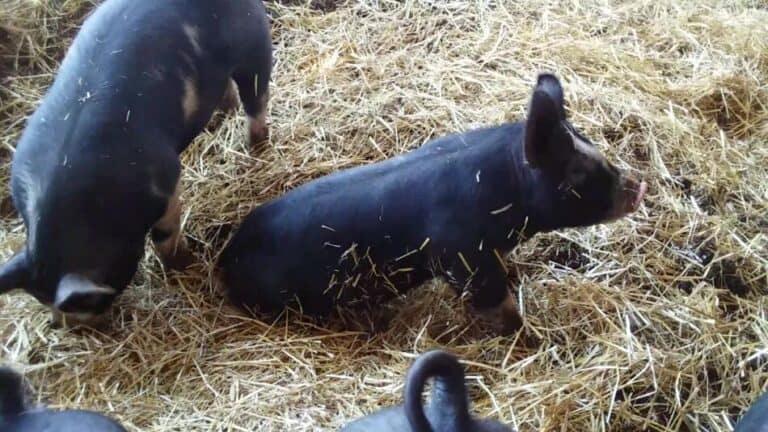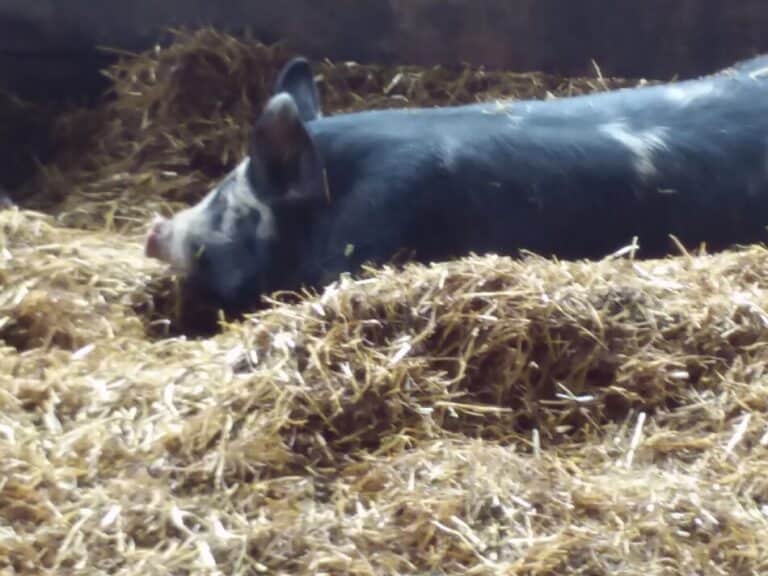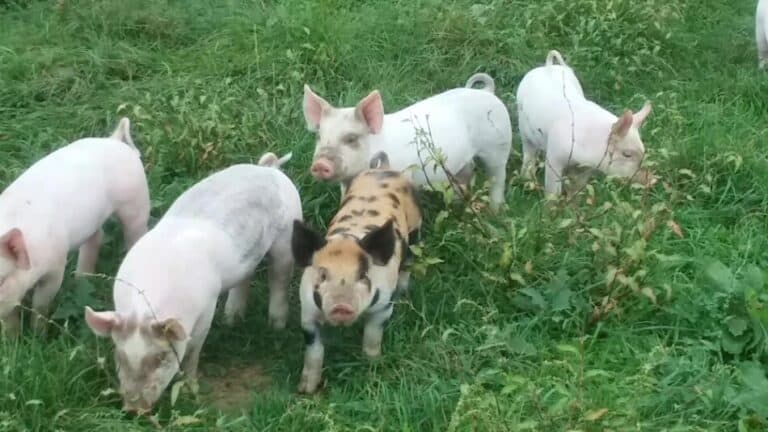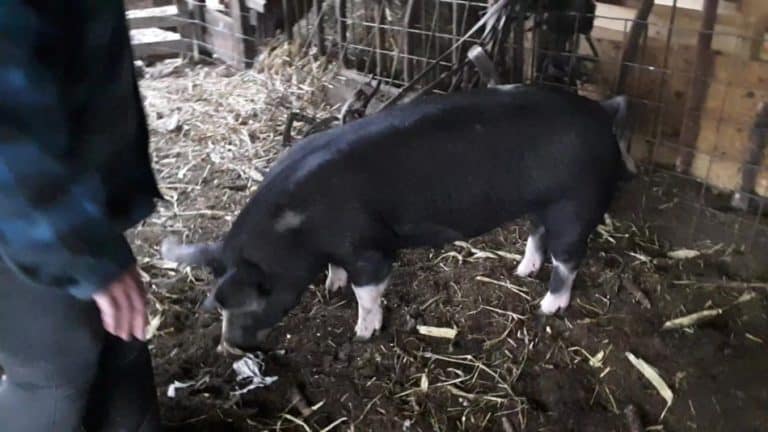Best Pigs For Beginners (Chart Included)
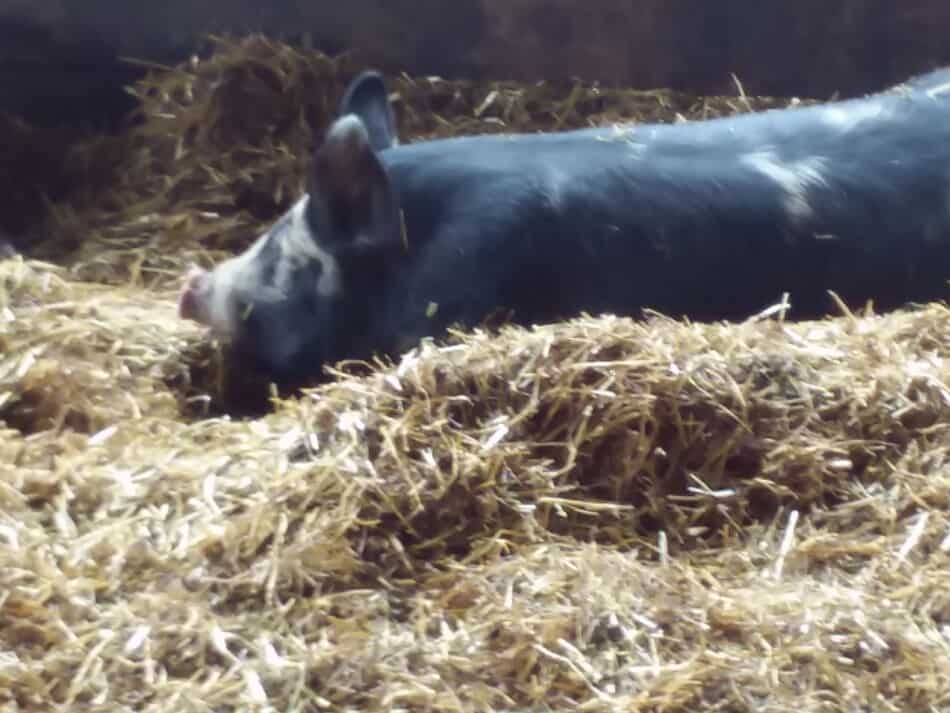
| Characteristic | Purebred pigs | Crossbred pigs |
| Priced for meat production | No | Yes |
| Have hybrid vigor | No | Yes |
| Good choice for potential breeding stock | Yes | Maybe |
| Fast and efficient growth are main selection criteria | No | Yes |
| Available for purchase/ease of finding piglets | Harder | Easier |
| Potential price per piglet | Higher | Lower |
Is Raising A Pig For Meat Worth It? will lay out the things you should know and the money you should plan on spending when raising your own pork.
Crossbred feeder pigs are the best beginner pigs
The best pigs for a beginner to raise are crossbred feeder pigs. These piglets have been bred specifically for meat production, so they are hardy and fast growers.
A crossbred piglets is normally a maternal line sow, think of the white breed pigs, crossed with a terminal line boar, think of the colored breeds.
This cross produces pigs called “blue butts” that are mostly white with a sprinkling of grey (called blue) splotches across the back side of the pig.
Blue butts are the most common meat pig cross because they grow well since using parents of two separate breeds takes advantage of hybrid vigor.
Hybrid vigor is when you cross two parent lines that are unrelated and get a faster growing, hardier piglet than you would get if you used parents of the same breed to produce piglets.
Crossbred piglets have the best of both worlds
Common crossbred pig breeding plans would be to use a white mom, like Yorkshire or Landrace, since she will have more piglets per litter and milk more, so the piglets grow faster, and a meat breed dad, like Duroc or Hampshire.
The cross gives you the best of both worlds, a mom that gets the piglets off to a great start and meatier genetics that produce a market hog with a higher carcass value.
If you kept only maternal line pigs, Landrace for example, you would get high litter numbers and good milking ability, but thinner built market hogs.
If you bred meat breed line pigs, Duroc for example, you would get meaty little piglets with lower litter numbers and milking ability on the part of the moms.
The specific breeds used to produce crossbred feeder pigs will differ
It does not matter so much which breeds of pigs are used to produce the pigs you plan to buy as long as one of the parents, usually the dad, is a breed selected for growth and meatiness.
Common choices for the sow include: Yorkshire, Landrace or a mix of the two.
Common choices for the boar include: Duroc, Berkshire and Hampshire.
Make sure the parent breeds are both commercial pig breeds
Do not get feeder pigs that are a small breed or new breed cross. These pigs will not finish at the rate or the weights that you are expecting.
While a cross containing a small breed or a new breed pig is a crossbred, these piglets will not give you the results you are looking for. Buy piglets of commercial crosses only.
Here is an article on Pig Breeds from Utah Pork. If your feeder pigs are a cross of these breeds, you are on the right track for getting great piglets.
Find the best crossbred pig for your area
Since crossbred feeder pigs are a mix, it only makes sense that each pig farmer has his or her own preferred mix, so which cross is the best?
Here the answer is easy, you want the cross that a local pig raiser uses because s/he has found this mix of genetics works best for the area.
For me, I am breeding my pigs for color and width, these are the traits that work the best/bring the most money around here. Long and lean pigs do not sell well in my area, Ohio.
In a hot area, you’d want ability to handle the heat, which would mean a more leanly built pig would be a better choice. Thickly built pigs would not grow well in this situation, the body type is wrong for the area.
These are all considerations that the local pig farmer has already figured out for your area.
Take advantage of the knowledge s/he has and buy the piglets that have been selected to grow well for your part of the country.
Unusual or rare breed pigs are more difficult to raise
Rare or unusual breeds of pigs are getting a lot of attention as the best pigs to raise. There are a lot of neat breeds available, but for a beginner they are a poor choice.
Unusual pigs are rare because they are different, usually slower growing, than other more commercially useful breeds of pigs. Since all pigs are raised for meat, this means rare breeds are not as quick or easy to raise.
As a beginner, you’ll be most successful if you keep things as simple as possible for the first few pigs you raise, just until you get the idea of how to raise pigs and what they need from you.
Once you are no longer a beginner, then if you think that a rare or unusual breed of pigs is a better choice for you, look into it.
For right now, make things easier on yourself and stick with a nice crossbred, like a blue butt.
If you want to look into other breeds of pigs, just to see the variety available, read Choosing The Best Pigs For Breeding Stock.
Raise your pigs on all they can eat feed
Now we are talking more about method of raising your pigs, give them all they can eat feed. This will give you the fastest growing pigs and be the best use of your time and money.
Raising Feeder Pigs: How Long Will It Take? will walk you through figuring up how much time you should plan to have your pigs, which will depend upon how you raise and feed them.
You can keep your pigs in a nice, well bedded pen or keep them outdoors in a pasture or woods, but either way, keep them with full feed and plentiful water.
Pigs will eat the amount of feed they need, you don’t need to limit feed access
The pigs will eat all they need, as long as you keep the feeder and waterer full. I like to give snacks of hay or extra vegetables to give the pigs a bit of a treat.
They seem to like the novelty of a new food, but these snacks are always in addition to full feed, never as a replacement to any feed.
Depending upon where you look for information, you can come across articles talking about feeding pigs for free or without buying any pig feed.
The catch is that pigs still need the calories for growth, so if they aren’t eating feed where are they finding all of the fuel to grow?
You don’t get something for nothing. Pigs need calories to grow. Not giving your pigs feed will drastically slow their growth, even when you supplement with other foods like pumpkins or whey.
